I was in a conversation with a company president recently who said to me, “The solution to our problem is CRM.” I responded, “Really? Interesting comment. Can you describe your problem again?”
 For the past 15 years, I have helped companies implement software to achieve specific business objectives. Sounds good, right? The challenge is, however, that so often there are no specific business objectives. Someone in the firm simply decided it was time to get new software. Or everyone in the firm grew frustrated with the current system. Something tipped the scales to the point that company leadership agreed to undertake the investment of time and money to investigate a new software solution. Worse, they may have just hired a hot shot new sales manager who said, “I ran XYZ at my last company, and if we implement that, I will turn this sales team around.”
For the past 15 years, I have helped companies implement software to achieve specific business objectives. Sounds good, right? The challenge is, however, that so often there are no specific business objectives. Someone in the firm simply decided it was time to get new software. Or everyone in the firm grew frustrated with the current system. Something tipped the scales to the point that company leadership agreed to undertake the investment of time and money to investigate a new software solution. Worse, they may have just hired a hot shot new sales manager who said, “I ran XYZ at my last company, and if we implement that, I will turn this sales team around.”
If these scenarios sound a bit loose, CRM implementations are even more so. The vast majority of the time, what happens is that company leadership decides it is time to “manage those darn sales people.” Good luck. If you can’t manage sales people with a manual system, you certainly are not going to implement software to do it for you. Sales management requires clarity of purpose, specific expectations, and reinforcement of these items on a regular basis with the sales team. Software alone will not solve your problem. Heck, you might not even have a problem. But for the sake of this episode, let’s agree that you do have a problem.
Here are the 3 steps to safeguard against CRM failure:
- The first step is to be able to put it in words. Describe the issue clearly. Then, describe what your situation would look like if you solved the problem.
- Now you can ask the question, “Is this is a process issue, a product/service issue, or a people issue?” CRM can solve one of these…the process. While you may be able to use a CRM system to better coach people, the fact is that software in general and CRM in particular only help enforce a process that is well defined.
- Who is going to own this project? If everyone owns the project, then no one owns the project. Regardless of who you choose, they must also have top executive support. Trying to implement a CRM system without the full support of the executives will lead to back door politics that will undermine your success.
Assuming that your problem can be solved with software, and you have clearly defined what success looks like, you are ready to begin the journey of selecting the appropriate system. For many of my Microsoft Dynamics NAV customers, they don’t even realize that they already own a CRM system. Microsoft Dynamics NAV is the only Dynamics ERP solution with Relationship Management embedded in the product. So, if you are lucky enough to already own Microsoft Dynamics NAV, you are well on the way to solving your problem. Contact your Partner, discuss your vision of the solution, and work together to set up Relationship Management to manage your sales process and people to achieve your goals.
You say you don’t already own Microsoft Dynamics NAV? Well, now you have project on your hands to select from the many alternatives available to you in the world of CRM. But, that is a topic for another episode…




